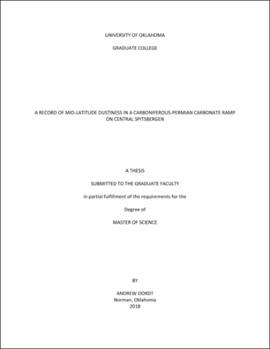| dc.description.abstract | This study focuses on a mid-latitude dust record from the Wordiekammen Formation, a carbonate ramp on Spitsbergen. The ramp developed on the Northern Pangean margin in Moscovian (Carboniferous) through Sakmarian (Permian) time at a paleolatitude of 30-35°N. The study site on the Nordfjorden High was isolated from any source of fluvio-deltaic input, such that detrital material that occurs in this system experienced eolian transport, thus forming a proxy for atmospheric dustiness. We analyzed two intervals, of Moscovian (10m) and Asselian (26.8m) age, at 20 cm resolution, and identified five mid-ramp subtidal facies organized in upwardly shallowing, high-frequency sequences 3-5 m thick. High-frequency sequence boundaries commonly exhibit signs of subaerial exposure (e.g. Microcodium) developed atop subtidal facies, recording glacioeustatic falls (glacials), although the Moscovian section has a severe karst overprint at sequence boundaries attributable to prolonged exposure during this interval. Samples were processed to isolate the silicate mineral fraction (SMF), which includes both detrital silicates, and authigenic silica mostly in the form of (fine sand-sized) doubly terminated quartz crystals. Detrital cores within these crystals records recrystallization from fine-grained (<30 µm) dust.
Analysis of the dust record demonstrates that the Asselian had a significantly higher atmospheric dust load than the Moscovian. Within the Asselian interval, dust input varies commensurate with glacial interglacial cyclicity. Highest dust contents correspond to transgressive facies at sequence boundaries, indicating peak atmospheric dust loading at lowstand to incipient interglacial times. Provenance data from detrital zircon and whole rock geochemistry indicate two distinct source regions for the dust. Dust from the Moscovian and lower Asselian intervals reflects a continental island arc signature consistent with sourcing from the basement of northeast Greenland. Dust from the upper Asselian interval is more consistent with recycling from Devonian and Carboniferous strata of the east Greenland Caledonides, likely deflated from fluvial systems draining this orogenic system, indicating an expansion of regions of eolian deflation. | en_US |
